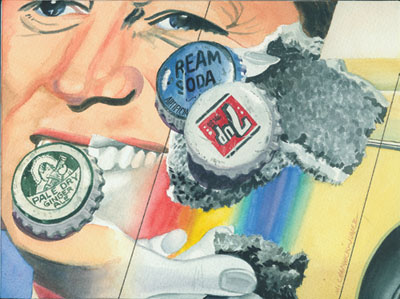Studio Assignment
For my studio assignment next week, I will be doing food photography. One such artist that does food photography is Marcus Nilsson, whose photography I will try to mirror in this upcoming studio assignment. Next week, I will bring in pretzels to take pictures of.
Photogram Research
A photogram is a picture produced with light-sensitive paper and some objects and no camera. Photogram artists include Imogen Cunningham and Christian Schad. Next week, I’ll bring in some household items to create my very own photogram.

Developing Review
1) In complete darkness, open the film canister, remove the film, load the film onto the reel, and then film the reel into the developing tank.
2) Put developer into the canister.
3) Pour the developer out.
4) Put the stop into the canister.
5) Pour the stop out.
6) Put the fix into the canister.
7) Pour the fix out.
A helpful video that shows you how to develop film…
Pop Art
The Pop Art Movement started in the mid-1950s and ended around the early 1970s. Some notable pop art artists include Andy Warhol, Roy Lichtenstein, and James Rosenquist as well as many others. Pop art is common on billboards and advertisements and celebrates popular culture. It was also commonly used in comics.





Link to my Pop Art Tutorial: http://www.photoshopessentials.com/photo-effects/pop-art/
My Pop Art
Composition Rules
1. The Rule of Thirds
Imagine that your picture has two vertical and two horizontal lines running across it, creating nine equal boxes. The Rule of Thirds states that you should place the most important items in your picture along these lines in order to add balance and interest to your photo.

http://en.wikipedia.org/wiki/Rule_of_thirds
2. Balancing Elements
Put the main subject of your photo off center to make it more interesting, but to fill the blank space left in the picture, add in an item of less significance to create more balance.

https://sites.google.com/site/photographycompositionrules/balancing-elements
3. Leading Lines
Since our eyes are naturally drawn to lines, where you place the lines in your photograph can make or break the picture. You can make the lines lead the viewer into the picture or away from it depending on where you place them. Lines can be anything from straight to diagonal to zigzag or even radial.

http://121clicks.com/tutorials/elements-of-composition-the-magic-of-leading-lines
4. Symmetry and Patterns
Symmetry and patterns are eye-catching, so having them in your picture can make it more intriguing. You can also create tension or a main focal point in your photograph by breaking the symmetry or pattern somewhere within it.

http://staff.4j.lane.edu/~holte/2003website/5.Elements.of.Photography.html
5. Viewpoint
Shoot from above, below, beside, behind, from far away, close up, and more to create the impact you want your photo to convey.
https://sites.google.com/site/photographycompositionrules/viewpoint-1
6. Background
Find a plain background or one with few distractions to add more focus onto the subject of the photograph.
http://www.freehdbackgrounds.net/widescreen-nature-background-photography-digital-wallcoo-mandc-800×600.htm
7. Depth
To create more depth in your picture, place the things in your photo at varying degrees from the camera or use the technique of overlapping.

http://www.digitalcameraworld.com/2012/12/17/photography-basics-how-to-add-depth-to-your-photos/
8. Framing
Framing pictures creates more focus on the subject. In order to frame a picture, place the things doing the framing along the edges of the photograph to isolate the main subject from everything else around it.

http://photographyblogger.net/framing/
9. Cropping
Crop photos to get rid of any things in the background that could distract the viewer from the main subject of the photograph.

https://ww2.lifepics.com/Photography-Tips/cropping-tips.htm
10. Experimentation
Take as many photographs as you can and try out new things to create interesting photos.

http://www.samhaskinsblog.com/?cat=318
My Composition Tips Techniques

















